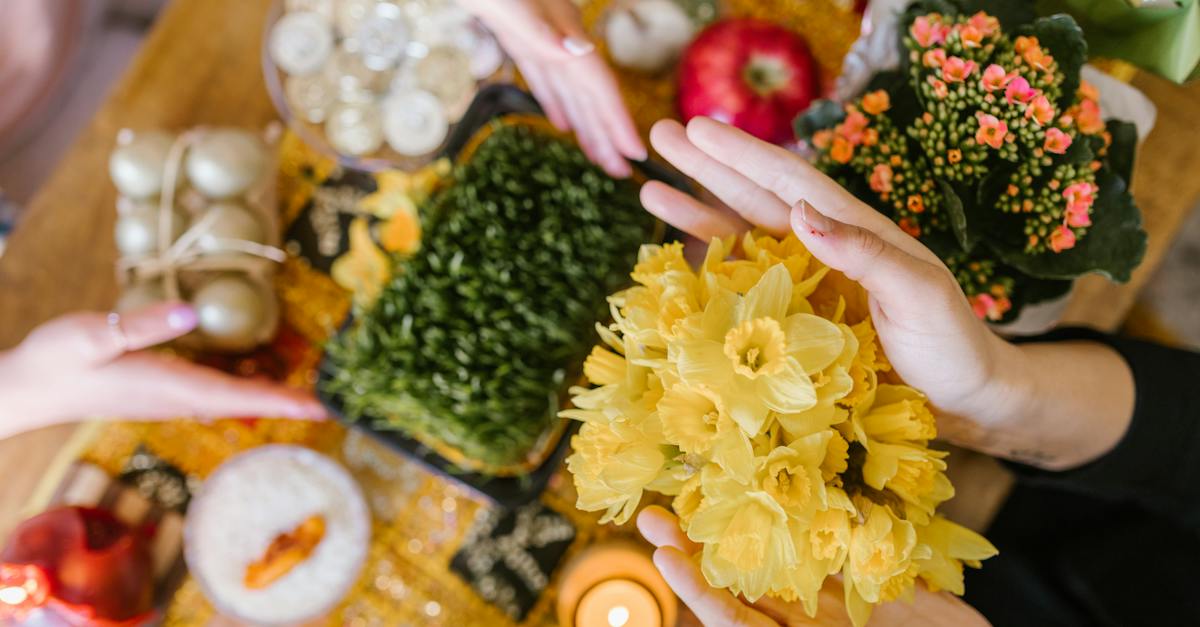As we bid farewell to another year and welcome the exciting promises of 2024, it’s time to indulge in the rich and vibrant flavors of traditional New Year’s foods. From savory delicacies to sweet treats, these culinary delights play a significant role in bringing luck, prosperity, and happiness for the year ahead. Join me on a mouthwatering journey as we explore the fascinating world of Happy New Year 2024 traditional foods.
In this article, I’ll be sharing a delightful assortment of traditional dishes from around the world that are believed to bring good fortune and joy in the New Year. We’ll uncover the secrets behind these age-old recipes and discover the cultural significance they hold. From the hearty lentil soups of Italy to the golden dumplings of China, get ready to tantalize your taste buds and learn about the fascinating traditions that surround these delectable dishes.
So, whether you’re looking to embrace your own cultural heritage or simply want to try something new and exciting this New Year, this article will serve as your ultimate guide to Happy New Year 2024 traditional foods. Get ready to savor the flavors of tradition and embark on a culinary adventure that will leave you craving for more.
Contents
Delightful Dishes from Around the World
Now that we’ve explored the cultural significance of traditional New Year’s foods, let’s dive into some delightful dishes from around the world that are enjoyed during this festive time. These dishes are not only delicious, but they also carry deep-rooted traditions and symbolism that make them perfect for celebrating the coming year.
1. Hoppin’ John – United States
In the southern United States, Hoppin’ John is a must-have dish on New Year’s Day. This dish is made with black-eyed peas, rice, and bacon or ham hock. According to tradition, eating Hoppin’ John on New Year’s Day brings good luck and prosperity for the year ahead. The black-eyed peas are said to represent coins, while the rice symbolizes wealth.
2. Tteokguk – Korea
In Korea, Tteokguk is the star of New Year’s celebrations. This hearty soup is made with sliced rice cakes served in a flavorful beef broth. It’s often topped with thinly sliced cooked egg, green onions, and seasoned seaweed. According to Korean tradition, eating Tteokguk during the New Year helps you age one year older and brings good luck for the coming year.
3. Osechi-ryori – Japan
In Japan, Osechi-ryori is a traditional New Year’s feast that consists of an array of beautifully presented dishes. Each dish has its own significance and is carefully crafted to bring good luck, prosperity, and health. Some of the common dishes found in Osechi-ryori include kuromame (sweet black beans), datemaki (sweet rolled omelet), kamaboko (fish cake), and kazunoko (herring roe). The vibrant colors and unique flavors of Osechi-ryori are a feast for the eyes and the taste buds.
4. Cotechino con Lenticchie – Italy
In Italy, Cotechino con Lenticchie is a popular dish served on New Year’s Eve. Cotechino is a type of pork sausage, and lenticchie are lentils. The dish is believed to bring good luck and prosperity for the new year. The lentils are said to resemble small coins, symbolizing wealth and abundance. The sausage, on the other hand, represents the richness and indulgence of the coming year.
Lentil Soups of Italy: A Symbol of Luck and Prosperity
Italy has its own traditional New Year’s dish that is believed to bring luck and prosperity for the coming year – Cotechino con Lenticchie. This mouthwatering dish consists of Cotechino, a type of Italian sausage, served with lentil soup.
Lentils have long been considered a symbol of good luck and prosperity in many cultures. Their small size and round shape resemble coins, making them a fitting symbol for wealth and financial success. In Italy, it is believed that the more lentils you eat on New Year’s Day, the more money you will have in the coming year.
Cotechino, the star of the dish, is a type of cooked pork sausage that is made from a mixture of pork fat and lean meat, seasoned with various spices. The sausage is slow-cooked and served sliced on top of a flavorful lentil soup. The combination of the tender and flavorful sausage with the earthy and satisfying lentils creates a harmonious and delicious dish.
The tradition of serving Cotechino con Lenticchie on New Year’s Day in Italy dates back centuries. It is believed that the dish brings good luck and abundance to households for the entire year. The lentils in the soup represent wealth, while the rich and fatty sausage symbolizes the indulgence and decadence that the new year brings.
In addition to being a symbol of luck and prosperity, Cotechino con Lenticchie is a dish enjoyed for its delicious flavors and comforting qualities. The lentil soup provides a hearty and nutritious base, while the tender sausage adds a savory and satisfying element.
So, if you’re looking to celebrate the new year with a taste of Italy, consider trying Cotechino con Lenticchie. Not only will you be indulging in a flavorful and satisfying dish, but you’ll also be embracing a tradition that has been passed down for generations.
Golden Dumplings of China: Bringing Wealth and Prosperity
Chinese New Year, also known as the Spring Festival, is a time of joyous celebration in China and is marked by various customs and traditions. One such tradition is the preparation and consumption of golden dumplings, which are believed to bring wealth and prosperity in the coming year.
Golden dumplings, or Jiaozi, are a staple food during Chinese New Year and hold significant cultural symbolism. The shape of the dumplings resembles ancient Chinese gold ingots, which were used as currency and represented wealth. By consuming these golden dumplings, it is believed that one will attract financial abundance and good fortune throughout the year.
The ingredients used in making golden dumplings also carry symbolism. The filling typically consists of minced pork, cabbage, and other ingredients, all of which represent abundance and prosperity. The use of golden colors, such as turmeric or saffron, adds to the visual appeal and the association with wealth.
The preparation of golden dumplings is a communal activity, often involving family and friends coming together to make and enjoy these delicious treats. It is a time of bonding and sharing stories, as well as passing down traditional techniques and recipes from generation to generation.
During Chinese New Year celebrations, families gather around the table to enjoy a feast of various dishes, including golden dumplings. The act of eating these dumplings is believed to bring luck and prosperity to everyone present. It is customary to place a coin or a small piece of paper with a written wish inside one of the dumplings. The person who finds this special dumpling is said to receive an extra dose of good luck for the year.
The tradition of eating golden dumplings during Chinese New Year is deeply rooted in Chinese culture and has been carried on for centuries. Whether it is the belief in attracting wealth or simply the joy of coming together with loved ones, these dumplings hold a special place in the hearts and palates of the Chinese people.
So, as the New Year approaches, why not try making some golden dumplings of your own? Not only will you delight your taste buds, but you may also welcome a year filled with wealth and prosperity.
Exploring Other Traditional New Year’s Foods
When it comes to celebrating the New Year, different cultures have their own unique traditions and customs. As we continue our culinary journey, let’s explore some other traditional New Year’s foods from around the world. These dishes are not only delicious but also carry deep symbolism and meaning.
Hoppin’ John from the United States
In the southern United States, a popular dish called Hoppin’ John takes center stage on New Year’s Day. Made with black-eyed peas, rice, and smoked pork, this dish is believed to bring good luck and prosperity for the coming year. The black-eyed peas symbolize coins, the rice represents wealth, and the pork signifies progress. Many people also serve collard greens alongside Hoppin’ John, as they are thought to bring even more financial success.
Tteokguk from Korea
Korean culture celebrates the New Year with Tteokguk, a hearty soup made with sliced rice cakes, beef broth, and various toppings. Eating Tteokguk is believed to grant good luck and add another year to one’s age. The chewy rice cakes resemble coins, symbolizing prosperity, while the act of consuming the dish represents leaving behind the old and embracing the new. Families gather together to enjoy this comforting soup and engage in the tradition of sebae, a formal bow to their elders to show respect and receive blessings.
Osechi-ryori from Japan
In Japan, the New Year is welcomed with Osechi-ryori, an assortment of beautifully presented dishes. Each item in the Osechi-ryori has its own significance and symbolism. For example, kurikinton, a sweet mashed chestnut, represents wealth, while kazunoko, herring roe, symbolizes fertility and a bountiful harvest. The meticulous preparation and vibrant colors of Osechi-ryori reflect the hope for a prosperous and harmonious year ahead.
Cotechino con Lenticchie from Italy
Italian tradition calls for a hearty meal on New Year’s Eve, with a dish called Cotechino con Lenticchie taking center stage. Cotechino is a type of large pork sausage, and lentils represent coins. It is believed that eating this dish will bring good fortune and financial success in the new year. The combination of Cotechino and lentils is a symbol of abundance and wealth.
Conclusion: Embracing Tradition and Delightful Flavors
As we conclude our exploration of traditional New Year’s foods from around the world, it’s clear that these dishes hold a special place in their respective cultures. From Hoppin’ John in the United States to Tteokguk in Korea, Osechi-ryori in Japan, and Cotechino con Lenticchie in Italy, each dish carries deep symbolism and significance.
These traditional foods are not only delicious but also believed to bring good luck and prosperity for the coming year. They provide a unique opportunity to embrace the rich cultural heritage and customs associated with New Year celebrations.
By incorporating these dishes into our own New Year’s feasts, we can not only experience delightful flavors but also connect with traditions that have been passed down through generations. It’s a wonderful way to honor our roots and celebrate the diversity of our world.
So, as we welcome the new year, let’s remember to savor the flavors of these traditional dishes and embrace the traditions that make each culture unique. May they bring joy, prosperity, and a sense of connection to all who enjoy them. Happy New Year!
What is Hoppin’ John?
Hoppin’ John is a traditional New Year’s dish from the United States, consisting of black-eyed peas, rice, and pork. It is believed to bring good luck and prosperity for the year ahead.
What is Tteokguk?
Tteokguk is a Korean dish commonly eaten on New Year’s Day. It is a soup made with sliced rice cakes and beef or chicken. Tteokguk symbolizes longevity and is enjoyed as part of Seollal, the Korean Lunar New Year.
What is Osechi-ryori?
Osechi-ryori is a traditional Japanese New Year’s cuisine. It consists of a variety of beautifully arranged dishes, including boiled fish, vegetables, and sweetened black beans. Osechi-ryori reflects cultural traditions and is thought to bring good luck and happiness for the upcoming year.
What is Cotechino con Lenticchie?
Cotechino con Lenticchie is an Italian dish commonly eaten on New Year’s Day. It consists of pork sausage, lentils, and spices. It is believed to symbolize abundance and prosperity. In Italy, it is said that the lentils resemble small coins, signifying good fortune and wealth in the new year.

